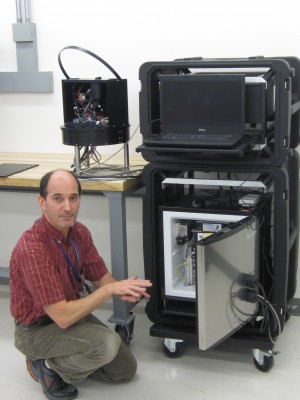Snazzy New Spectroradiometers Sport Same Body, Different Mind
Published: 1 June 2011

For accurate climate studies, scientists need to know the amount of energy coming from the sun. One way they get this information is through data collected by sensors called radiometers. Through the American Recovery and Reinvestment Act of 2009, ARM is now providing data from a new type of radiometer, called the shortwave array spectroradiometer (SAS). The new instrument began providing additional measurements of solar energy at ARM’s Southern Great Plains site in January. Another is part of the ARM Mobile Facility instrument suite, currently in India and preparing for the Ganges Valley Aerosol Experiment, or GVAX.
The new SAS instrument is really two systems—a zenith (vertical-pointing) system and a hemispheric (180-degree field-of-view) system, or SASZE and SASHE, respectively. Joined at the hip, so to speak, the SASZE and SASHE operate in tandem and are virtually identical, except for…
A few important differences
Both instruments use the same motors, data acquisition hardware, and electronics that are housed within matching climate controlled enclosures and connected via optical fiber to the sensor housing outside. Only the final collection optic and the configuration of shadowbands are different:
- the collection optic for the SASZE limits the measurement to light from within a small 1-degree patch of sky directly overhead
- the collection optic for SASHE collects sky light from the entire hemisphere.
And while both systems use a band to the block the sun, the role of the “shadowband” for the two systems is quite different. For the SASZE, the shadowband blocks the sun continuously to prevent any accidental exposure to direct sunlight during the entire measurement. For the SASHE, the shadowband follows a sequence of programmed movements, alternately blocking and revealing the sun. This permits a separate measurement of direct solar and diffuse hemispheric sky light.
This difference in operating mode results in different measured quantities and different time scales for the SASZE and SASHE:
- SASZE provides measurements once every second during daylight hours, including throughout twilight before the sun has risen and after it has set.
- SASHE provides direct solar and diffuse hemispheric measurements at approximately 20-second intervals, but can be configured for alternate programming sequences.
How they stack up
Several components in the new SASZE and SASHE represent significant improvements over the existing shortwave spectrometer designs. Essentially an offspring of the existing Shortwave Spectrometer, the SASZE provides higher spectral resolution and better isolation from direct sunlight. Similarly, the SASHE is a cousin to the Rotating Shadowband Spectrometer, but extends the longwave limit from about 1000 nanometers to about 1700 nanometers.
Climate researchers will benefit from the SASZE and SASHE measurements that can improve models by permitting comparisons between calculated and measured sky light, but can also be used in conjunction with models to infer atmospheric composition from the measured sky light.
The ARM Climate Research Facility is a DOE Office of Science user facility. The ARM Facility is operated by nine DOE national laboratories, including .
Keep up with the Atmospheric Observer
Updates on ARM news, events, and opportunities delivered to your inbox
ARM User Profile
ARM welcomes users from all institutions and nations. A free ARM user account is needed to access ARM data.


















